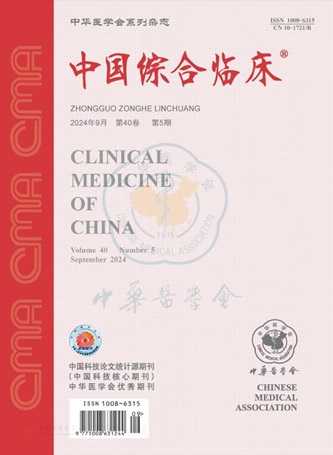Effect of laparoscopic salpingotomy on ovarian reserve function in patients with tubal pregnancy
引用次数: 0
Abstract
Objective To investigate the effect of laparoscopic salpingotomy and salpingectomy on ovarian reserve function in patients with tubal pregnancy. Methods From October 2014 to March 2017, 201 cases of tubal pregnancy in Jizhong energy Fengfeng Group Hospital were selected and divided into observation group (112 cases) and control group (89 cases) according to different treatment methods.The observation group was treated with laparoscopic salpingectomy, while the control group was treated with laparoscopic salpingectomy.The number of sinus follicles and ovarian volume were measured by color Doppler ultrasound at third days of menstruation on first, third, sixth months after the operation respectively and the ovulation was detected in 6 months after the operation.The intrauterine pregnancy of the two groups was observed one year after operation. Results There was no significant difference in the number and volume of healthy ovarian antral follicles between the two groups in 1, 3 and 6 months after operation respectively (all P>0.05). The number of sinus follicles in the 1, 3 and 6 months after the operation were (7.71 ± 3.12), (7.86 ± 2.03) and (7.65 ± 1.89) in observation group respectively, while that in the control group were (4.06 ± 1.05), (3.91 ± 1.14) and (4.89±2.03)respectively.There was no significant difference in the number of sinus follicles in different time groups (Fintra-group=0.573, P>0.05). The difference between the groups was statistically significant (F inter-grouP=634.306, P 0.05). The difference between the groups was statistically significant (Finter-group=449.106, P< 0.01), F interaction=261.017, P< 0.01). The ovulation rate at 6 months (82.1%, 92/112) and intrauterine pregnancy rate at 1 year (71.8%, 79/110) in the observation group were higher than those in the control group (56.2%, 50/89) and (31.0%, 27/87). There were significant differences between the two groups(χ2=12.601, 28.753, all P<0.05). Conclusion Laparoscopic salpingotomy is better than salpingectomy in the treatment of tubal pregnancy.The ovulation rate and intrauterine pregnancy rate are also superior to salpingectomy.It shows that laparoscopic fenestration can protect the ovarian reserve reserve function and reproductive function of patients. Key words: Tubal pregnancy; Laparoscopy; Oviduct fenestration; Salpingectomy; Number of sinus follicles; Ovarian volume腹腔镜输卵管切开术对输卵管妊娠患者卵巢储备功能的影响
目的探讨腹腔镜输卵管切除术和输卵管切除术对输卵管妊娠患者卵巢储备功能的影响。方法选取2014年10月~ 2017年3月冀中能源丰丰集团医院输卵管妊娠患者201例,根据治疗方法不同分为观察组112例和对照组89例。观察组患者行腹腔镜输卵管切除术,对照组患者行腹腔镜输卵管切除术。分别于术后第1、3、6个月月经第3天采用彩色多普勒超声检测窦性卵泡数和卵巢体积,术后6个月检测排卵情况。观察两组患者术后1年的宫内妊娠情况。结果两组患者术后1、3、6个月健康卵巢窦卵泡数量和体积比较,差异均无统计学意义(P < 0.05)。观察组术后1、3、6个月的窦卵泡数分别为(7.71±3.12)个、(7.86±2.03)个、(7.65±1.89)个,对照组分别为(4.06±1.05)个、(3.91±1.14)个、(4.89±2.03)个。不同时间组鼻窦卵泡数比较差异无统计学意义(Fintra-group=0.573, P < 0.05)。组间比较差异有统计学意义(F - group =634.306, p0.05)。组间差异有统计学意义(Finter-group=449.106, P< 0.01), F交互作用=261.017,P< 0.01)。观察组6个月排卵率(82.1%,92/112)和1年宫内妊娠率(71.8%,79/110)均高于对照组(56.2%,50/89)和(31.0%,27/87)。两组间比较差异有统计学意义(χ2=12.601, 28.753,均P<0.05)。结论腹腔镜输卵管切开术治疗输卵管妊娠优于输卵管切除术。排卵率和宫内妊娠率均优于输卵管切除术。提示腹腔镜开窗可保护卵巢储备功能和患者的生殖功能。关键词:输卵管妊娠;腹腔镜检查;输卵管开窗术;输卵管切除术;窦卵泡数;卵巢体积
本文章由计算机程序翻译,如有差异,请以英文原文为准。
求助全文
约1分钟内获得全文
求助全文
来源期刊
CiteScore
0.10
自引率
0.00%
发文量
16855
期刊介绍:
Clinical Medicine of China is an academic journal organized by the Chinese Medical Association (CMA), which mainly publishes original research papers, reviews and commentaries in the field.
Clinical Medicine of China is a source journal of Peking University (2000 and 2004 editions), a core journal of Chinese science and technology, an academic journal of RCCSE China Core (Extended Edition), and has been published in Chemical Abstracts of the United States (CA), Abstracts Journal of Russia (AJ), Chinese Core Journals (Selection) Database, Chinese Science and Technology Materials Directory, Wanfang Database, China Academic Journal Database, JST Japan Science and Technology Agency Database (Japanese) (2018) and other databases.

 求助内容:
求助内容: 应助结果提醒方式:
应助结果提醒方式:


